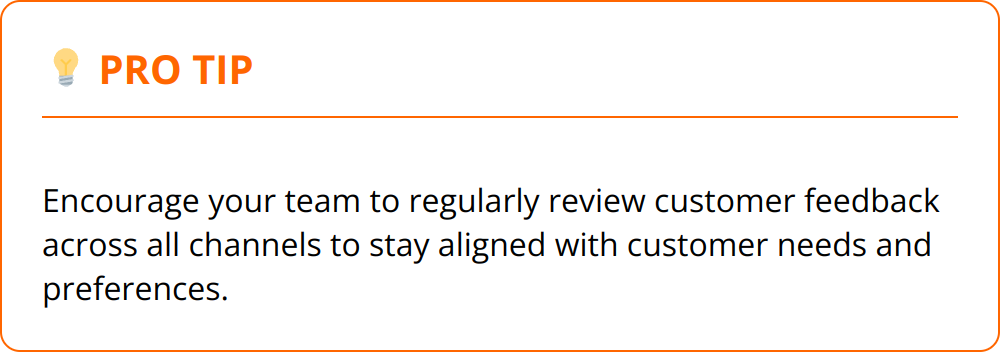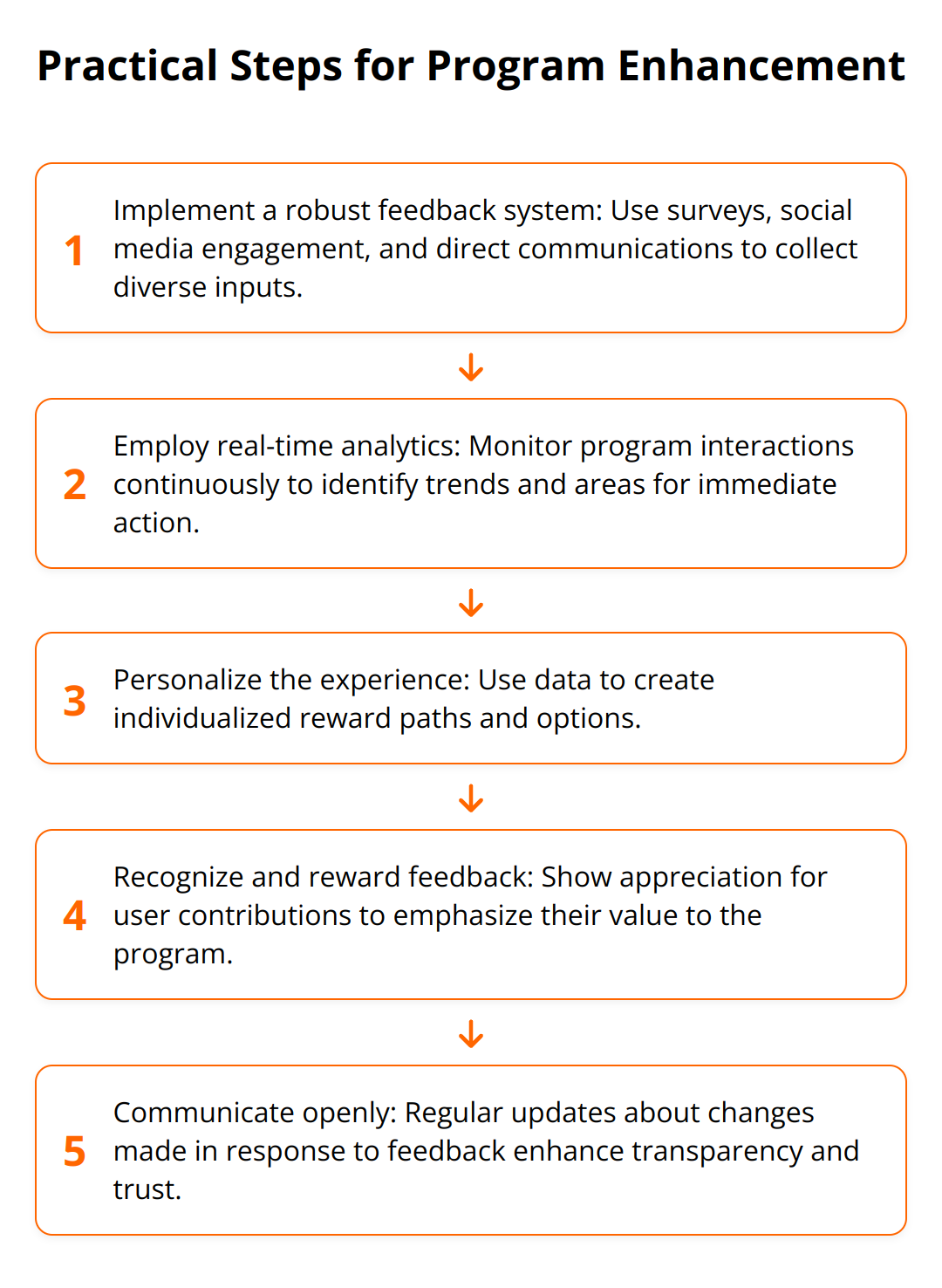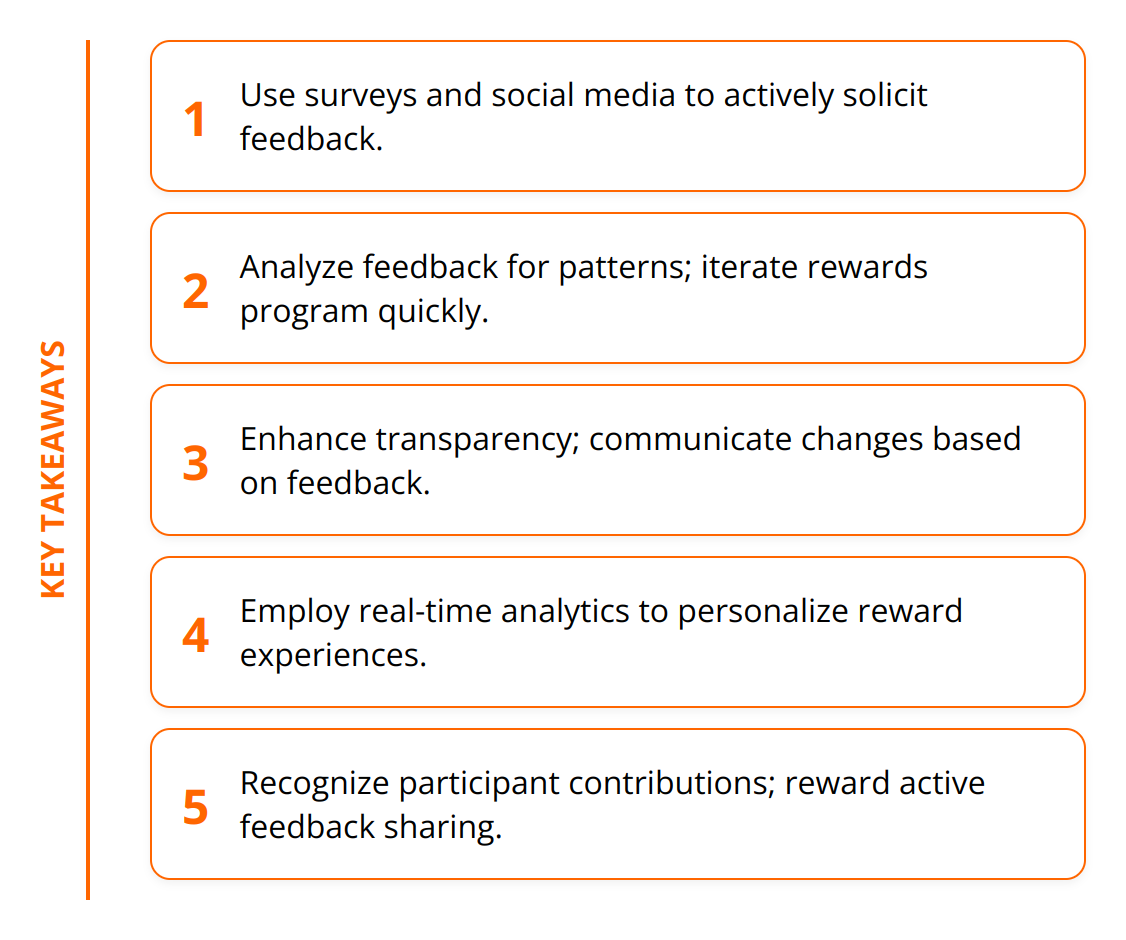
Feedback loops are essential mechanisms within reward programs that drive customer engagement and foster continuous improvement. At Reward the World, we’ve seen firsthand how they can transform customer experience and satisfaction. This post: What to Know About Reward Program Feedback Loops, explores the ins and outs of feedback loops, highlighting their importance and effective implementation. Join us as we break down how these elements contribute to the success of a reward program.
Harnessing Feedback in Reward Programs
Feedback loops in reward programs are not just beneficial; they’re indispensable for fostering long-term customer engagement and improving the overall program structure. By integrating customer feedback directly into the reward program’s evolution, businesses can create more personalized, responsive, and ultimately successful initiatives. Here’s why:
Feedback loops effectively bridge the gap between customers’ expectations and the actual rewards they receive. This direct line of communication allows program administrators to adjust offerings based on real user preferences and experiences, rather than on assumptions. When customers feel heard and see their input reflected in the reward offerings, their satisfaction and loyalty increase. This is not just theory; it’s a proven approach that drives deeper engagement.
One concrete example of feedback loop success can be found in the way companies have adapted their reward programs to offer more digital rewards options. As more consumers have shown a preference for digital rewards — such as e-gift cards or online service subscriptions — companies that have listened and adjusted their rewards catalogs accordingly have seen significant upticks in engagement rates. They’re not just offering rewards; they’re offering the right rewards, proving the effectiveness of incorporating customer feedback.
Effective feedback loops entail more than just collecting feedback; they also require acting on it efficiently. From our experience, here are some actionable tips to make feedback loops genuinely impactful:
- Actively solicit feedback: Use surveys, feedback forms, and direct communication channels to gather insights from participants.
- Analyze feedback comprehensively: Look for patterns and recurring themes in the feedback to identify areas for improvement or opportunities to innovate.
- Communicate changes: Let participants know how their feedback has been instrumental in shaping the reward program. This not only validates their input but also encourages further engagement.
- Iterate quickly: Implement changes based on feedback in a timely manner to keep the program dynamic and responsive to participant needs.

For companies looking to deepen their understanding of feedback loop implementation within reward programs, exploring resources like customer engagement incentives can provide both inspiration and practical guidance.
In conclusion, feedback loops are more than a good practice; they’re a cornerstone of effective reward programs. They allow businesses to tailor their offerings to meet and exceed customer expectations, fostering a stronger connection between the brand and its users. Through active listening, thoughtful analysis, and swift action, any reward program can tap into the transformative power of customer feedback.
Elevating Customer Engagement
Enhancing customer engagement through effective feedback loops involves three main components: continuous listening, data analysis, and personalization. These elements are integral to understanding and meeting customer needs, thus fostering deeper connections and loyalty.
Continuous Listening: The Heartbeat of Programs
Continuous listening forms the core of a dynamic feedback loop. It’s not enough to ask for feedback occasionally; businesses must actively seek it regularly and through various channels. Surveys and social media are potent tools for this, providing direct lines to customer perceptions and experiences. Adopt practices that encourage ongoing conversations with your audience. For example, leverage social media polls to gauge preferences on reward options or send out short, frequent surveys post-reward redemption to capture immediate feedback. This approach ensures that your program remains relevant and aligned with customer expectations.

Leveraging Data Analysis for Informed Decisions
Once feedback is collected, the next critical step is data analysis. This is where you turn raw data into actionable insights. Analyzing patterns in customer behavior and feedback helps pinpoint what’s working well and what needs improvement. For example, if data shows a high redemption rate for a specific type of reward but negative feedback regarding its delivery process, it indicates a need to refine the fulfillment aspect. Tools and platforms that offer in-depth analytics can support this process by providing comprehensive data visualization and trend analysis capabilities.
Tailoring Experiences Through Personalization
The final piece of the puzzle is personalization. In today’s market, personalization is not just preferred; it’s expected. Customers want to feel that the offerings are curated specifically for them. Combining the insights gained from continuous listening and data analysis paves the way for creating highly personalized reward programs. This could mean offering rewards that align with individual customer’s purchasing habits or even allowing them to create a wishlist of rewards. Additionally, a timely response to feedback, be it positive or negative, reinforces a sense of value and acknowledgment.
Practical Tips for Effective Feedback Loops
- Utilize popular social media platforms to engage with customers and gather feedback.
- Automate survey distribution after specific interactions to capture real-time feedback.
- Implement advanced analytics tools to uncover deep insights from customer data.
- Develop a personalization strategy that allows for flexible reward options based on customer preferences.
- Communicate changes made in response to feedback, enhancing transparency and trust.
Following these practices not only elevates customer engagement but turns feedback loops into a strategic asset for continuous program improvement. Through active listening, insightful analysis, and thoughtful personalization, businesses can create reward programs that truly resonate with their audience.
Enhancing Reward Programs
To truly elevate the performance and appeal of reward programs, incorporating feedback loops into the strategic framework is essential. This move isn’t just about addressing immediate customer concerns but about embedding a culture of continuous improvement and innovation within the program. Here, we explore practical aspects of enhancing reward programs through feedback loops, focusing on integrating customer feedback, leveraging technology for real-time feedback gathering, and strategies to encourage active participation from users.

Successful reward programs are dynamic, evolving with the preferences and expectations of their participants. This adaptive nature is only possible through a systematic approach to integrating customer feedback. Companies must establish regular checkpoints to gather insights and actively seek out suggestions and critiques. Real-world data is invaluable; it provides clear guidance on what’s working and what’s not. More importantly, it shines a light on potential innovations that could set a program apart from competitors.
Leveraging technology plays a pivotal role in this process. Today, numerous platforms and tools can facilitate real-time feedback gathering and analysis. For example, in-depth analytics tools offer a way to track engagement and satisfaction levels, presenting opportunities to quickly pivot or fine-tune the program based on user interactions. Another key aspect is personalization — technology enables us to tailor experiences at an individual level, significantly boosting engagement and loyalty.
To stimulate active participation, programs must not only be engaging but also communicate their value and receptiveness to feedback. Recognition of contributions, whether through public acknowledgment or additional rewards, fosters a sense of community and investment in the program’s success. Moreover, transparency about how feedback is used to shape the program reinforces trust and encourages continued participation.

Practical Steps for Program Enhancement
- Implement a robust feedback system: Use surveys, social media engagement, and direct communications to collect diverse inputs.
- Employ real-time analytics: Monitor program interactions continuously to identify trends and areas for immediate action.
- Personalize the experience: Use data to create individualized reward paths and options.
- Recognize and reward feedback: Show appreciation for user contributions to emphasize their value to the program.
- Communicate openly: Regular updates about changes made in response to feedback enhance transparency and trust.
Incorporating these strategies will not only enhance the effectiveness of reward programs but also ensure they remain compelling and relevant to their audiences. Active engagement, bolstered by responsive feedback loops, lays the groundwork for truly successful and enduring reward initiatives.
Wrapping Up
The essence and impact of feedback loops within reward programs cannot be overstated. They are the linchpin in creating a vibrant, responsive, and customer-centric rewards ecosystem. The dialogue between a business and its customers, facilitated by effective feedback mechanisms, ensures that reward offerings remain relevant, engaging, and genuinely appreciated by the end-users. The integration of customer feedback into the continuous refinement of reward programs underlines a commitment to excellence and customer satisfaction.

We strongly encourage businesses of all sizes to embrace feedback loops as a strategic asset. By doing so, they not only heighten customer engagement and satisfaction but also forge stronger, more meaningful connections with their audience. The ability to listen, adapt, and respond promptly to customer feedback is a hallmark of a dynamic and resilient business, poised for growth and long-term success.
Looking forward, the evolution of reward programs with embedded feedback loops promises to be both exciting and transformative. As reward programs become more sophisticated, leveraging advanced analytics and personalization, the role of feedback loops will become increasingly central. Businesses that harness the power of real-time customer insights and engage in an ongoing dialogue with their users will set new standards in customer loyalty and program innovation.
Reward the World stands at the forefront of this evolution, offering a comprehensive and dynamic global incentives platform that meets the needs of modern businesses and their customers. With a vast array of instant rewards, seamless integration, and state-of-the-art analytics, our platform is designed to elevate customer engagement and drive business performance. We invite you to explore how Reward the World can empower your business to achieve its goals through the strategic use of feedback loops and personalized rewards.
In conclusion, feedback loops are not just a good business practice; they are a critical component of successful reward programs. They ensure that businesses stay in tune with their customers’ needs and preferences, leading to improved satisfaction, loyalty, and business outcomes. As we move forward, the integration of feedback loops into reward programs will continue to be a key driver of innovation and customer engagement. We will publish further: What to Know About Reward Program Feedback Loops as we move along.
